Abstract
In this work, we employ the Navier–Stokes–Korteweg system of equations for the simulation of phase transition flows. This system belongs to the diffuse interface models, in which both phases are separated by a non-zero thickness interface where the properties vary continuously. The key idea of these methods is the ability to use the same set of equations for the entire computational domain, regardless of the phase of the fluid. However, these methods lead to a system of equations with high-order derivatives, which are difficult to discretize and solve numerically. Here, we propose the use of a high-order Finite Volume method, FV-MLS, for the resolution of the Navier–Stokes–Korteweg equations. The method uses Moving Least Squares approximations for the direct and accurate discretization of higher-order derivatives, which is particularly suitable for simulations on unstructured meshes. In this work, we show two numerical examples in which the interface is set to interact with great changes in the properties, in order to demonstrate the robustness of the method.
Access this chapter
Tax calculation will be finalised at checkout
Purchases are for personal use only
References
Anderson DM, McFadden GB, Wheeler AA (1998) Diffuse-interface methods in fluid mechanics. Annu Rev Fluid Mech 30:139–165
Korteweg DJ (1901) Sur la forme que prennent les équations du mouvements des fluides si l’on tient compte des forces capillaires causées par des variations de densité consiérables mais continues et sur la théorie de la capillarité dans l’hypothèse d’une variation continue de la densité. Archives Néerlandaises des Sciences Exactes et Naturelles. Series II 6:1–24
Jamet D, Torres D, Brackbill JU (2002) On the theory and computation of surface tension: the elimination of parasitic currents through energy conservation in the second-gradient method. J Comput Phys 182:262–276
Diehl D (2007) Higher order schemes for simulation of compressible liquid-vapor flows with phase change. PhD thesis
Gómez H, Hughes TJR, Nogueira X, Calo VC (2010) Isogeometric analysis of the isothermal Navier-Stokes-Korteweg equations. Comput Methods Appl Mech Eng 199:1828–1840
Cueto-Felgueroso L, Colominas I (2008) High-order finite volume methods and multiresolution reproducing kernels. Arch Comput Methods Eng 15(2):185–228
Cueto-Felgueroso L, Colominas I, Nogueira X, Navarrina F, Casteleiro M (2006) High order finite volume schemes on unstructured grids using Moving Least Squares construction, Application to shallow waters dynamics. Int J Numer Methods Eng 65:295–331
Cueto-Felgueroso L, Colominas I, Nogueira X, Navarrina F, Casteleiro M (2007) Finite volume solvers and moving least-squares approximations for the compressible Navier-Stokes equations on unstructured grids. Comput Methods Appl Mech Eng 196:4712–4736
Khelladi S, Nogueira X, Bakir F, Colominas I (2011) Toward a higher order unsteady finite volume solver based on reproducing kernel methods. Comput Methods Appl Mech Eng 200(29):2348–2362
Lancaster P, Salkauskas K (1981) Surfaces generated by moving least squares methods. Math. Comput. 37(155):141–158
Nogueira X, Ramírez L, Khelladi S, Chassaing J, Colominas I (2015) A high-order density-based finite volume method for the computation of all-speed flows. Comput Methods Appl Mech Eng 298:229–251
van der Waals JD (1873) On the continuity of the gaseous and liquid states. PhD thesis
van der Waals JD (1979) The thermodynamic theory of capillarity under the hypothesis of a continuous variation of density. J Stat Phys (Reprinted) 20:197–244
Serrin J (2008) The area rule for simple fluid phase transitions. J Elast 90:129–159
Rusanov VV (1962) The calculation of the interaction of non-stationary shock waves and obstacles. USSR Comput Math Math Phys 1(2):304–320
Li X-S, Gu C-W (2013) Mechanism of Roe-type schemes for all-speed flows and its application. Comput Fluids 86:56–70
Liu J, Gómez H, Evans JA, Hughes TJR, Landis CM (2013) Functional entropy variables: a new methodology for deriving thermodynamically consistent algorithms for complex fluids, with particular reference to the isotermal Navier-Stokes-Korteweg equations. J Comput Phys 248:47–86
Ramírez L, Nogueira X, Khelladi S, Chassaing J-C, Colominas I (2014) A new higher-order finite volume method based on moving least squares for the resolution of the incompressible Navier-Stokes equations on unstructured grids. Comput Methods Appl Mech Eng 278:883–901
Author information
Authors and Affiliations
Corresponding author
Editor information
Editors and Affiliations
Rights and permissions
Copyright information
© 2019 Springer Nature Switzerland AG
About this chapter
Cite this chapter
Martínez, A., Ramírez, L., Nogueira, X., Navarrina, F., Khelladi, S. (2019). A High-Order Finite Volume Method for the Simulation of Phase Transition Flows Using the Navier–Stokes–Korteweg Equations. In: Ferrer, E., Montlaur, A. (eds) Recent Advances in CFD for Wind and Tidal Offshore Turbines. Springer Tracts in Mechanical Engineering. Springer, Cham. https://doi.org/10.1007/978-3-030-11887-7_12
Download citation
DOI: https://doi.org/10.1007/978-3-030-11887-7_12
Published:
Publisher Name: Springer, Cham
Print ISBN: 978-3-030-11886-0
Online ISBN: 978-3-030-11887-7
eBook Packages: EngineeringEngineering (R0)

